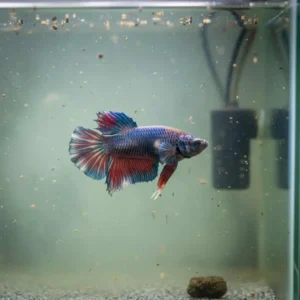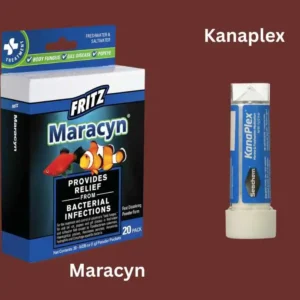Seeing your betta fish sick can break your heart. I remember the first time one of my bettas developed dropsy. His belly swelled up like a pinecone, and I felt helpless. After ten years of keeping bettas, I’ve learned everything about this serious condition. Let me share what I know to help you save your fish.
Dropsy is not actually a disease itself. It’s a symptom of internal organ failure in betta fish. When you notice your betta bloated with scales sticking out, that’s dropsy. Quick action can save your fish’s life.
| Aspect | Details |
| Main Symptom | Swollen belly with pinecone-like scales |
| Common Cause | Bacterial infection affecting kidneys |
| Treatment Success | Low if caught late, better if early |
| Treatment Time | 7-14 days with medication |
| Prevention | Clean water and proper diet |
Dropsy happens when fluid builds up inside your fish’s body. The organs stop working properly, and water can’t be regulated. This makes your betta look puffy and sick.
Identifying Dropsy Early
What does a sick betta look like when it has dropsy? The signs are quite clear once you know what to watch for. I check my bettas every morning during feeding time. This habit has saved several of my fish over the years.
The most obvious sign is the pinecone appearance. Your betta’s scales will stick out from their body instead of lying flat. This happens because fluid pushes the scales outward. The belly becomes extremely swollen and rounded. Your fish may look like it swallowed a marble.
Here are the key symptoms to watch for:
Why does my fish look bloated if it’s not dropsy? Sometimes bettas get constipated from overfeeding. But constipation doesn’t cause the pinecone scales. That’s the key difference. Dropsy in betta fish shows both symptoms together – swelling and raised scales.
I once had a beautiful blue betta named Splash. He started acting sluggish one Tuesday morning. By evening, his scales were starting to stick out. I began treatment immediately, and he survived. Early detection matters tremendously with this condition.

What causes dropsy? This question puzzled me for years when I first started keeping bettas. The truth is, dropsy fish betta cases usually stem from bacterial infections. But it’s more complicated than just bacteria.
Betta fish diseases dropsy develops when the kidneys and other internal organs fail. The most common culprit is a bacteria called Aeromonas. This nasty organism attacks your betta’s organs. When the kidneys stop working, fluid builds up inside the body cavity.
Poor water quality is the biggest risk factor. Dirty water weakens your betta’s immune system. Ammonia, nitrites, and high nitrates stress the fish. Stressed fish get sick more easily. I learned this lesson the hard way with my first betta tank.
Other causes include:
What is dropsy disease really about? It’s your betta’s body giving up the fight against infection. The organs can’t remove waste or control fluid balance anymore. Think of it like a plumbing system that stops working. Everything backs up and overflows.
Genetics can play a role too. Some bettas are simply more prone to organ problems. But even healthy fish can develop dropsy if conditions are poor. Prevention is always easier than cure with this condition.
Taking Action to Save Your Fish
How to treat dropsy in betta fish requires quick action and dedication. I won’t sugarplant it – treatment is challenging. The success rate depends on how early you catch it. But don’t give up hope. I’ve saved several bettas with proper treatment.
First, move your betta fish with dropsy to a hospital tank. Use a small 2-3 gallon container with a heater and gentle filter. This keeps the sick fish away from healthy ones. It also makes medication more effective and less expensive.
Raise the water temperature to 78-80°F. Warmer water speeds up metabolism and helps medication work better. Add an aquarium salt bath at 1 teaspoon per gallon. Salt helps reduce fluid buildup and supports organ function. Change 50% of the water daily to keep it clean.
How to cure dropsy in betta fish involves more than just salt though. You need antibiotics that can penetrate the fish’s body and fight internal bacteria. This is where medication becomes essential for treating dropsy betta fish disease.
Choosing the Right Medicine
Treatment for dropsy requires strong antibiotics. Regular fish medicines often don’t work well enough. You need something that targets internal bacterial infections specifically. I keep several medications on hand for emergencies.
The best options include:

Follow the package directions exactly. Don’t skip doses or stop early. Even if your betta looks better, finish the full treatment course. Stopping too soon lets resistant bacteria survive.
My Top Medication Choice for betta fish dropsy
Kanaplex from Seachem is my go-to medicine for dropsy disease in betta fish. I’ve used it successfully many times over the years. This medication contains kanamycin sulfate, which fights gram-negative bacteria like Aeromonas.
Mix Kanaplex directly into the hospital tank water. Use one measure per 5 gallons every 48 hours. Do a 25% water change before each new dose. Treat for at least 7-14 days total.
Why do I prefer Kanaplex? It penetrates tissues deeply and fights internal infections effectively. It’s also less harsh on your betta’s organs than some alternatives. The powder form is easy to measure and store.
Combine Kanaplex with Metroplex for even better results. This combination attacks both bacterial and potential parasitic causes. Many experienced betta keepers use this duo for serious infections.
Feed high-quality foods during treatment. Frozen bloodworms or daphnia provide nutrition without stressing digestion. Your betta needs energy to fight the infection. Keep the tank dark and quiet to reduce stress.
Keeping Your Fish Healthy
Prevention is a million times easier than treating dropsy. After losing my first betta to this condition, I became obsessed with prevention. These simple habits have kept my fish healthy for years.
Maintain excellent water quality always. Test your water weekly with a reliable kit. Ammonia and nitrites must stay at zero. Nitrates should stay below 20 ppm. Do weekly water changes of 25-30% minimum.
Feed a varied, high-quality diet. Don’t overfeed your betta. One or two small meals daily is plenty. Skip one day per week to prevent constipation. Frozen or live foods are healthier than dried pellets alone.
Key prevention steps:
Keep your betta’s tank at least 5 gallons. Bigger is always better for water stability. Small bowls get dirty fast and stress fish. Stressed bettas get sick more often.
Watch for early warning signs daily. Changes in behavior often happen before physical symptoms appear. A betta that suddenly hides all day or refuses food needs attention. Catching problems early makes treatment much easier.
Clean your tank decorations monthly. Bacteria can build up on surfaces. Use hot water only – no soap. Rinse everything thoroughly before putting it back.
Can dropsy spread to other fish?
The bacteria that causes dropsy can spread to other fish. That’s why you should always quarantine sick bettas immediately. However, healthy fish with strong immune systems usually resist infection. Clean water and low stress keep your other fish safe.
Is dropsy always fatal in betta fish?
Dropsy caught very early has a slim chance of recovery with aggressive treatment. Unfortunately, most cases are fatal because the internal damage is too severe. The survival rate is roughly 20-30% even with proper medication. Prevention is crucial for this reason.
How long does it take for dropsy to kill a betta?
Without treatment, dropsy usually kills a betta within 1-2 weeks. With treatment, you might extend this to 3-4 weeks. Early intervention gives the best chance of survival. Once the pinecone scales appear, the condition has already progressed significantly.
Can dropsy be caused by overfeeding?
Overfeeding alone doesn’t cause dropsy directly. However, it can lead to constipation and water quality problems. Poor water quality then weakens the immune system and allows bacterial infections. So overfeeding contributes to the conditions that enable dropsy to develop.
Should I euthanize a betta with dropsy?
This is a personal decision only you can make. If your betta is suffering severely and not responding to treatment after 7-10 days, euthanasia may be the kindest option. Look for signs like inability to swim, gasping for air, or complete loss of appetite.
Dealing with betta fish dropsy is one of the hardest challenges for any fish keeper. I’ve been through it multiple times in my ten years of experience. The key is catching it early and acting fast with proper medication like Kanaplex.
Remember that prevention through clean water and good nutrition is your best weapon. Check your betta daily and maintain their tank regularly. These simple habits will help your fish avoid this devastating condition.
If your betta does develop dropsy, don’t lose hope right away. Start treatment immediately with antibiotics and salt baths. Some fish do recover, especially when caught early. But also be prepared for the possibility of saying goodbye.
The most important lesson I’ve learned is this: a healthy betta is a happy betta. Focus on creating the perfect environment, and you’ll rarely face serious health problems. Your fish depends on you for everything. Give them the best care possible.